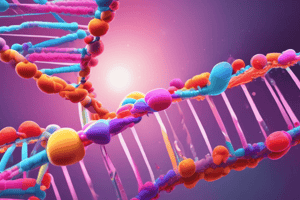Podcast
Questions and Answers
What portions of DNA can code for proteins?
What portions of DNA can code for proteins?
- Proteins
- RNA
- Genes (correct)
- Amino acids
What is protein synthesis?
What is protein synthesis?
DNA into the making of a protein
What are proteins involved in?
What are proteins involved in?
Transport, structure, acting as enzymes, and protecting the body
Where is DNA located?
Where is DNA located?
What is the function of RNA?
What is the function of RNA?
What is transcription?
What is transcription?
What does RNA polymerase do?
What does RNA polymerase do?
What is mRNA?
What is mRNA?
What is the function of a ribosome?
What is the function of a ribosome?
What is translation in protein synthesis?
What is translation in protein synthesis?
What does tRNA do?
What does tRNA do?
What does a codon represent?
What does a codon represent?
What is an anticodon?
What is an anticodon?
What is a codon chart used for?
What is a codon chart used for?
What holds amino acids together from tRNA?
What holds amino acids together from tRNA?
Study Notes
Key Concepts in Protein Synthesis
- Genes: Segments of DNA that encode information to produce proteins, influencing traits like eye color.
- Protein Synthesis: The biological process where DNA is translated into proteins, crucial for various cellular functions.
Proteins and Their Functions
- Proteins: Essential macromolecules involved in numerous functions such as transportation, structural support, enzymatic activity, and immune protection. Vital for life.
DNA and RNA
- DNA: Found in the nucleus, serves as the blueprint for all genetic information.
- RNA: Transports genetic information from the nucleus to the cytoplasm, facilitating protein production.
Transcription Process
- Transcription: The process of converting DNA into an RNA message, occurring in the nucleus.
- RNA Polymerase: Enzyme that catalyzes the formation of RNA by linking RNA bases to complementary DNA bases.
mRNA and Ribosomes
- mRNA (messenger RNA): A type of RNA that carries genetic information from DNA to ribosomes in the cytoplasm for protein synthesis.
- Ribosome: Cellular machinery composed of ribosomal RNA (rRNA) that synthesizes proteins during translation.
Translation Mechanism
- Translation: The phase of protein synthesis where the mRNA message is decoded to form a specific protein.
- tRNA (transfer RNA): Molecules that transport specific amino acids to the ribosome, matching them to the corresponding codon on the mRNA.
Codons and Anticodons
- Codon: A sequence of three nucleotide bases on mRNA that specifies a particular amino acid during translation.
- Anticodon: A complementary sequence of three bases on tRNA that pairs with a codon on mRNA; for example, UAC pairs with AUG and carries the amino acid methionine.
Codon Chart
- Codon Chart: A tool used to identify which amino acid corresponds to a specific codon, aiding in understanding the genetic code.
Peptide Bonds
- Amino Acids from tRNA: These building blocks of proteins are linked together by peptide bonds during the translation process, forming polypeptide chains.
Studying That Suits You
Use AI to generate personalized quizzes and flashcards to suit your learning preferences.
Description
Test your knowledge on protein synthesis with these flashcards from the Amoeba Sisters. Learn about the key terms like genes, DNA, and proteins involved in this vital biological process. Perfect for students studying biology and genetics!




